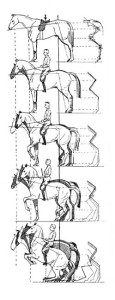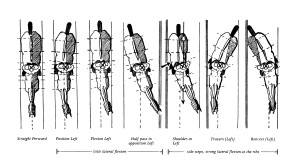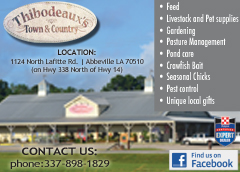Written by Wilhelm Mueseler
Original Publish Date August 2014
First published in English in 1937, Riding Logic (Reitlehre in the original German) provides clear and wise explanations for the training of the rider and the schooling of the horse. Mueseler de-mystifies many concepts in dressage, jumping, and general horse management. If you have ever wondered about performing half-halts, collection, or lateral work, or wondered about curing rearing, bucking, or shying, or wondered about the right way to work a green horse, a ruined horse, or a well-trained horse, this book is for you.
 Mueseler believes that anyone can learn to ride by learning skills, but only a few will become experts of the equestrian art – by studying the physiology and psychology of the horse and by perfecting “feel.” One point that Mueseler makes over and over is that the horse has a wonderful long-term memory and a very short short-term memory. Once a lesson is learned, a horse will remember, even if the lesson is negative, like “Bucking gets rid of this annoying human.” On the other hand, if a correction—a touch of the spur, a tap of the whip—isn’t immediate, the horse will not understand why he is being punished. Mueseler also believes that horses want to be petted, that they are naturally good-natured, and that they want to be friendly with humans. Nevertheless, they are not like dogs, he says; they are not as smart and not as brave. Nor are they machines. A good rider treats a horse like a living being “with a psychology all his own.”
Mueseler believes that anyone can learn to ride by learning skills, but only a few will become experts of the equestrian art – by studying the physiology and psychology of the horse and by perfecting “feel.” One point that Mueseler makes over and over is that the horse has a wonderful long-term memory and a very short short-term memory. Once a lesson is learned, a horse will remember, even if the lesson is negative, like “Bucking gets rid of this annoying human.” On the other hand, if a correction—a touch of the spur, a tap of the whip—isn’t immediate, the horse will not understand why he is being punished. Mueseler also believes that horses want to be petted, that they are naturally good-natured, and that they want to be friendly with humans. Nevertheless, they are not like dogs, he says; they are not as smart and not as brave. Nor are they machines. A good rider treats a horse like a living being “with a psychology all his own.”
The diagrams in the book show, with thin or thick arrows, the pressures that the rider uses with seat, legs, and hands. One of the famous illustrations in Riding Logic demonstrates (and de-mystifies) the notion of “bracing the back” in the half-halt: a line drawing of a rider pushing a book farther onto a table by moving his hips forward. The vectors—the arrows showing pressure—prove useful in Mueseler’s discussions of lateral work. Just how do you perform a shoulder-in? The arrows show how the rider’s inside leg provides impulsion and bend, his outside leg holds the hindquarters on the track, his inside hand positions the head, and his outside hand collects the horse’s frame. (Do not purchase the 2007 edition, Riding Logic: Transform Riding Skills to Art on Horseback. The new, color photos do not do a good job of illustrating the concepts in the text. Buy the 1965, 1966, or 1978 edition.)
Since Mueseler is a German, his book might seem too theoretical for some readers. The “logic” of his riding method can make perfect sense while you are reading, but when you are perched on the flesh-and-blood reality of your own horse it is hard to remember which directions the “arrows” are supposed to go or what in the world the “half-pass in opposition” is. In that case, just find a few truths in the book that you can repeat to yourself as you ride: 1) Seat and legs first, then hands. 2) Correct instantly. 3) Be patient. 4) Ask for a little more forward than the horse wants to give. 5) Use pats, soothing words, and relaxation to let the horse know you are pleased. Better yet, find a teacher who is patient, methodical, and well-trained in Mueseler’s art form, classical dressage.
You will not find “tricks” in Riding Logic. Things like Spanish Walk (pawing the air with each walk step; a circus movement), “rollkur” (hyperflexion, with nose to chest), or shortcuts have no place in Mueseler’s regimen. If you follow his advice, you will create a horse and rider that are ready to ride the trails, conquer jumps, collect, bend, extend, and, most important, create beauty and harmony.





